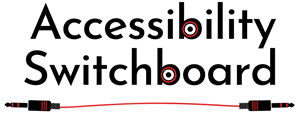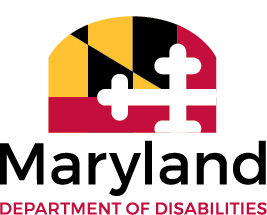How to provide an accessible work environment
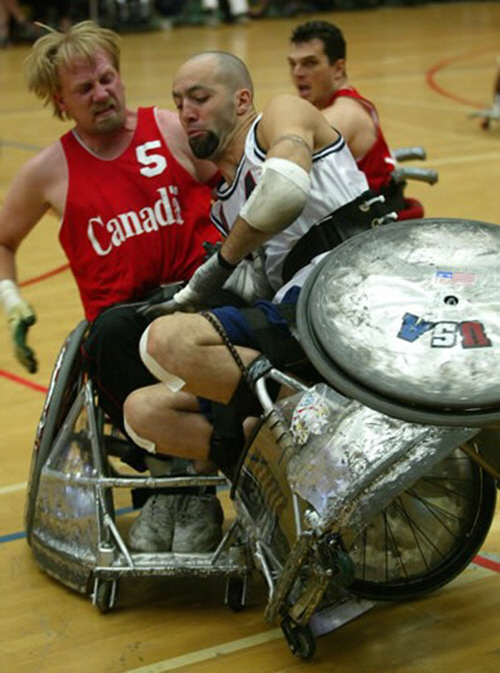
You defied expectations, rewrote the record books and turned ill-found pity into pride.—Sir Philip Craven
This guide is about the sorts of things you need to consider when setting out to make your environment accessible. As a precursor to action, the guide first covers the need to look at abilities in individuals first, and consider disabilities second, third, or even later. We provide links to further published resources providing checklists on individual topics such as human resources, facilities, and technology. In order to use such lists effectively, we provide a six step process to prepare your organization to make lasting change. This process begins with attaining executive support for change initiatives, and ends with continued monitoring and assessments of individual and team performance with respect to accessibility.
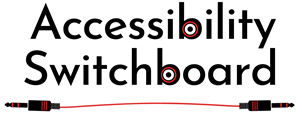
This guide was developed as part of
The Accessibility Switchboard Project
from the
National Federation of the Blind Jernigan Institute
January 2017, Version 1.0.
Creative Commons License: CC BY-SA 4.0
Introduction and Background
No pity
People were in awe at what you could do and forgot about what they believed you could not. You showed to the world that with a positive attitude the human body, and above all the human heart and mind, knows no limits and absolutely anything is possible.
—Sir Philip Craven, President of the International Paralympic Committee, September 19, 2016.
People mistakenly assume that people with disabilities are fragile and need protecting. If you look at the battered dented sides of the chairs used by wheelchair rugby participants, you’re not looking at fragile individuals. It’s a natural human trait to feel sorry for people who are less fortunate. However, the overwhelming message from the disability community is that pity isn’t wanted. Access to jobs and participation in society are what’s wanted.
When we don’t spend a lot of time around people with disabilities, we make ill-formed assumptions, and are surprised when we find out we’re wrong: “Wait, you’re blind? How on earth did you make it across town and then find our building?”; “I took the bus. People do that every day, it’s not unusual. Now, about this programming job you have on offer?”
‘Disability’ can be defined as the reduction or absence of given functional capabilities. Functions include seeing, hearing, speaking, physical tasks (lifting, typing, grasping, etc.) and cognitive tasks (remembering, reasoning, abstraction, etc.). In the workplace, for any individual who has a disability related functional limitation there are three scenarios to consider:
- The functional limitation is irrelevant to the job tasks. For example, it’s a desk job using computers and the phone, and the employee has a prosthetic leg.
- The functional limitation has relevance to the job tasks, and there is an accommodation. For example, it’s a desk job using computers and the phone, and the employee is blind, and the accommodation is to install speech output software on the computer.
- The functional limitation has relevance to the job, but there is no accommodation available. For example, the job is to lift heavy items onto shelves in a factory, sometimes requiring the use of ladders and operating forklift trucks, and the person uses a wheelchair.
This guide mostly covers scenarios A and B.
Why not C? For scenario C, people with disabilities are not looking for jobs that are clearly out of the realm of possibility due to functional constraints. Maybe when robotic powered exoskeletons are widely available, this sort of job might be available to a wheelchair user. Scenario C is rare.
For Scenario A, where the functional limitation is irrelevant to the job tasks, the presence of a disability may only create a passing interest to others, just the same as any scenario that brings in something new to a wider group. Beyond that passing interest, any responses evoking pity or other negative cultural stereotypes can be countered by training and other corporate culture improvements.
For Scenario B, where there is an accommodation available for a relevant functional limitation, this situation can evoke apprehension in the person doing the hiring if they don’t know what the accommodation might be. The quick solution is to just ask the job applicant: “How do you interact with computer software with your type of low vision?”. You don’t have to know in advance or be prepared for every type of accommodation eventuality. Instead, it is better to be prepared to address needs as they arise, and be open to new opportunities. Some accommodations may cost more than others, but generally speaking accommodation costs are a tiny fraction of salary costs, and an almost imperceptible fraction of the typical corporation’s human resource costs.
The biggest problems happen when people are untrained, and in their minds they confuse Scenario A for Scenario B, or they mistakenly assume Scenario B must be Scenario C because they don’t personally know of an available accommodation.
This is why the most important precursor to creating an accessible work environment is to always consider abilities first. Sort out accommodations (if they are needed at all) second, third, or even later when running down the hiring or promotion checklist. As for pity, it has no place on any such checklist.
Defining ‘Environment’
This guide is about providing an accessible work environment. What do we mean by ‘environment’? The elements of the environment that affect accessibility are:
- The people. This includes both employees with disabilities, and employees who are nondisabled.
- The physical environment. Parking, signage, buildings, seating, lighting, restrooms, etc.
- The employee ICT environment. The Information and Communications Technologies that people use in their daily work, such as phones, copiers, computers, security door entry systems. This also includes any technology accommodations used by employees with disabilities.
For elements of the work environment given above, it is quite easy to search the web for advice in the form of checklists. There are also compendium books and other resources, some of which we have included in the step-by-step guidance below. Some checklists are regulation-based, and others are best-practice based.
Thinking it through (beyond checklists)
A checklist has its place, but it doesn’t always get you what you really need. A useful supplementary approach is to have those responsible for a given topic think it through from the perspective of people who are experiencing functional limitations. For example, thinking through the installation of automatic opener switches on restroom doors, from the point of view of, say, a wheelchair user:
- We need to have pushbutton door openers on the restrooms. We need those to be usable 24/7 every day. What could affect that? Well, the energy saving policy is that on Friday evening the security guard turns off all the switches for the weekend. If they also turn off the power to the door opener unit located above the door jamb, then a wheelchair user won’t be able to use the restroom at the weekend. Let’s adjust the policy and the training of the security staff to make sure they know not to turn off these particular switches.
By asking people to think through their decisions that affect the environment, we can avoid problems that might not be caught by checklists. You may even find that filling in the checklist only after thinking through the use case scenarios results in better solutions than those that would be achieved by relying primarily on checklists. (Interestingly, you’re unlikely to find ‘think it through’ on any checklist.)
You don’t employ demographics
Checklists, by design, cover groups of people. Standards and regulations are written for addressing the needs of certain demographic groups. That provides you with a baseline, but you don’t employ demographics, you employ people who have individual needs, and sometimes multiple needs. It is important, therefore, when designing environments, designing policies, designing processes and so on, to also incorporate flexibility to meet unique needs as they arise.
Step-by-step: Making work environments accessible
For the following, we suggest Step 1 (executive support) be achieved before moving on. Steps 2 through 5 can best be achieved in sequence and over several iterations as needed. Step 6 is for ongoing monitoring once new elements are in place.
Step 1: Get executive support
Trying to cause change ‘from the ground up’ by asking peers nicely may be met with polite nods of agreement, but agreement only in principle. To get agreement in practice you need to have responsibility and accountability assigned, and that can only come from executive mandates. Any new initiative that affects a number of different departments in an organization will require the support of the relevant executives. For this reason we suggest that obtaining executive support for proposed initiatives is Step 1, and this should be established before moving forwards. For those who need more guidance on selling the idea of accessibility to executives, we have produced a separate guide entitled “Introducing organization-wide accessibility approaches: A guide to making a successful Pitch”. In the guide we cover (1) strategy; (2) maturity measures, and tactical options; and (3) cost and time estimate planning.
Step 2: Make the budget inclusive
When you make the pitch for including accessibility in an environment where accessibility has previously been overlooked or dealt with as an afterthought, you may encounter push-back with questions such as “how much is this going to cost?” and “where do you want me to come up with the additional money?” There are three basic responses to such questions, with increasing levels of effectiveness:
- Set up a new budget with new money. This might be a reflex reaction, but it isn’t advisable. It ensures that people think of dealing with accessibility as an ‘extra’ or as something ‘separate’. Besides, just where is the new money coming from?
- ‘Tax’ the various departments. In this response, the responsibility is shared by the various departments (HR, development, customer support, etc.) in terms of money being extracted from their annual budget, but the activities funded by the money are carried out by a separate accessibility team or office. This response is one up from the reflex action, but it doesn’t solve the problem of accessibility being considered as “something separate that we don’t have to do because someone else does that”.
- Make each department include accessibility as part of their budget. Accessibility affects employees, and employees can be in any department. If the goal is to make the ‘work environment’ accessible, then accessibility tasks need to be carried out by each department. By making accessibility a line item on each department’s annual budget, the responsibility and accountability are more clearly defined as being on those departments and their staff.
Option 3 is the most inclusive.
Sensible budget policies are required to prevent accessibility solutions being held up in red tape. For example, it may happen that a test of whether something is ‘readily achievable’ occasionally comes up. Budget considerations may have to go beyond the boundaries of a single department. An executive level budget decision may be required for something that arises that is beyond any one department’s means, but which is not a burden to the company as a whole.
Note: Most accessibility solutions are low or no cost, especially if they are built in from the beginning rather than inserted as a retrofit later on. If accessibility costs appear to be out of hand or outrageous, consider investing in a bit more research into a given problem. There are seldom if ever any aspects of providing an accessible work environment that haven’t already been successfully solved at a reasonable cost in other organizations.
Step 3: Assign responsibility for the various aspects of the environment
The people, the facilities, the ICT used by employees, and the management that hold things together: each area needs to have responsibility and accountability for accessibility assigned to individuals and teams. Where people are coming into their respective areas as novices, there are resources available to someone help get started. For these audiences, we have produced introductory guides and ‘Q&A’ articles. These are posted on related sections of the Accessibility Switchboard website (see the section at the end of this guide). Other resources in each area include more detailed background and detailed guidance, along with checklists for implementing new programs:
- Management. This includes executive and director level issues that concern various departments, and interactions spanning multiple departments. This also includes the setup and running of any cross-organizational ‘accessibility program office’ or equivalent.
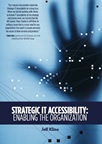 A resource for those addressing accessibility in management…
A resource for those addressing accessibility in management…
Strategic IT Accessibility: Enabling the Organization by Jeff Kline. This book provides background information and guidance for anyone wanting to make a start in organization-wide change. Specific guidance is given on organizational roles and shared responsibilities; and on funding accessibility initiatives.
- Human Resources. For hiring, retention and promotion of people with disabilities in the workforce, HR offices need to incorporate accessibility as a part of every day business operations. Training of all staff, including those who are nondisabled, is essential. The provision of appropriate and timely accommodations, both technical and nontechnical, fall under he HR function.
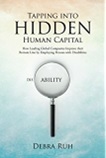 A resource for those addressing accessibility in human resources…
A resource for those addressing accessibility in human resources…
Tapping into Hidden Human Capital is a book by Debra Ruh. The book provides background on disabilities, discusses new global trends in business, and includes a chapter on ‘Blending Disability Inclusion into the Organization’. The book includes numerous business case studies.
- Facilities. The physical buildings, signage, parking, and so on fall under facilities. This includes the maintenance and upkeep of existing facilities, as well as the design and creation of new offices and other workplace elements.
 A resource for those addressing the accessibility of facilities…
A resource for those addressing the accessibility of facilities…
Universal Design: Creating Inclusive Environments is a book by Edward Steinfeld & Jordana Maisel. The book goes beyond the basics of accessible ramps and restrooms. It is a useful book for thinking of the environment as a whole to be used by people rather than a set of features to be checked off.
- The ICT used by employees. This includes technology accommodations used by individual employees and how those devices and software accommodations interact with your technology infrastructure. It can also include considerations of employees using their own devices if those are already accessible. Usually, the ICT that people address initially are things like enterprise software, the intranet, any ‘cloud’ services, and any mobile computing devices. However, additional considerations that sometimes get inadvertently overlooked are things like security access (badge entry systems, biometric identification, etc.), and incidental technologies that employees use (food order kiosks in cafeterias, food and drink vending machines, televisions in break rooms, etc.). The employee IT support team are also an essential element of the technology environment (are your IT Help Desk staff trained to help employees who have disabilities?).
Case study: Target's interactions with ICT vendors
Target's approach to working with vendors in digital platforms serves as a model for interaction with any ICT vendor: “A member of Target’s accessibility team is assigned to work on key projects, including partnerships with vendors, throughout every stage of development. The accessibility team is unique in this respect: for example, the UX team and the quality assurance team are engaged at specific stages as necessary, but not through the entire "soup-to-nuts" of design, development, and quality assurance. An early indication of the need for this approach was when certain would-be contractors would unwittingly reveal their lack of experience in this area ("What do you mean you want this to be accessible?"), or they would think they have it covered ("We already know what accessibility is!"), but their existing products didn’t come close to meeting Target’s standards.”
From ‘Target’s Design System Incorporates Accessibility as Standard’
published by NFB's Center of Excellence in Nonvisual Access.
 A resource for those addressing the accessibility of ICT used by employees…
A resource for those addressing the accessibility of ICT used by employees…
Ensuring Digital Accessibility through Process and Policy is a book by Jonathan Lazar, Daniel F. Goldstein, & Anne Taylor. The book provides background on disabilities, and the technologies used by people with disabilities. The book covers the many aspects of setting up a program and providing continued monitoring and testing of ICT (‘digital’) accessibility.
Note: The guidance above covers ICT used by employees with disabilities. In addition, consider the accessibility of the products you make and/or the services you deliver. If those are intended to be used by your employees when they interact with your customers, then accessibility considerations for these also fall under the umbrella term of ‘environment’. (See our related article: How do I ensure my products work for people with disabilities?)
Step 4: Require people to ‘think it through’ in terms of functional limitations
“Vending Machine Roulette” is a term used by many who are blind. This refers to the simple act of getting a coke (or is it a sprite or a ginger ale or a sparkling water?) and a sandwich (or is it an apple or a candy bar or a bag of chips?) from vending machines that don’t speak the names of the items for sale. When they can, blind individuals have to rely on sighted individuals for help, or if they are working late or at the weekend, and no one else is around, getting a drink and a snack is a game of chance.
What if those in charge of facilities and ICT were to think it through when the vending machine contract was up for renewal? “Can our blind colleagues use your machine? No? Why not? Come, on even my phone talks, why can’t you include that function?”
Maybe the present answer is “no”. But, if enough customers ask, maybe the answer in the near future will be “yes”. (After all, it’s been a quarter century since talking public use machines were introduced, and over fifteen years since talking ATMs became ubiquitous.)
By requiring those responsible for accessibility to conduct thought exercises on how various elements of the work environment will be used by people experiencing various functional limitations, better choices can be made in purchasing existing technologies, and manufacturers may start selling more accessible technologies (assuming manufacturers are responsive to customer requests).
For ‘thinking it through’ at a high level, consideration of the needs of people with various types of functional limitation can be helped by seeking the opinions and input from employee affinity groups (see our guide on “Beyond offering employees a complaint process”). For addressing issues that a given individual with a disability is having, include the individual in the process.
Step 5: Checklists and Change Management
As stated earlier, going through a thought process—of whether elements of the environment will be accessible to people experiencing functional limitations—could be more productive than starting with a checklist. (And, checklists typically don’t include ‘think it through’ as an item.)
There is a place for checklists, however. Checklists can help as a means of maintaining development quality, as well as in change management.
In regular development, checklists can be part of regular quality assurance review process activities. At the end of development checklists can be used in quality control to determine whether products are ready for delivery to the customer. Readily available resources on the topics of HR, facilities, and digital accessibility either include checklists, can be used to generate your own checklists, or they point to other commonly used checklists.
In practice, the cycles of ‘thinking it through’ and the generation of checklists can be iterative, with both getting more useful over time. What is clear is that over-reliance on checklists without consideration of consequences can result in oversights and errors that may prove wasteful of resources. In tackling changes to resources and/or environments, having a process of ‘thinking it through’ from an inclusion point of view will aid in the management and execution of needed changes.
Step 6: Monitor, assess, and include as performance indicators
Jane is blind and is a new hire. She comes into the office to begin her fourth month of employment. She doesn’t have any accessible technology on her assigned laptop computer yet. Adding the needed screen reader software is required to work the machine, and adding new software to any machine requires sign-off by the IT Security Team. Since Jane is the first blind employee, the IT Security Team needs to carry out their due process to make sure that there are no software vulnerabilities to be concerned about. The process might take a couple of hours, but the IT Security Team is over-worked and busy on two new major software updates. They can’t get to Jane’s issue because it hasn’t been tagged as a ‘priority’. (It is not unheard of for people with disabilities to have to wait six months in some places for a ‘new’ software request to be addressed, even when they have a work stoppage as a result.)
This monitoring and assessment Step is where policies and ideal processes can break down.
One way to work towards fewer ‘breakdowns’ in the system is to make accessibility part of staff and management performance indicators. This helps make accessibility something that is a priority and something that gets onto people’s agendas: “Bob, you had three new projects this year and for every one of them I had to ask you whether you had worked out accessibility issues, and you replied that you hadn’t because you were too busy and it slipped your mind. I’m gonna have to give you a negative score on Accessibility this time, Bob.” There’s nothing like real accountability to get things done.
Changing your business environment to be more inclusive requires thought, and requires changes to be introduced and managed. Without any kind of checks and balances, the implementation can fail.
In the event of failure, go back to Step 1.
In the event of success, spread the word.
Go In-Depth
 A resource for understanding legal requirements…
A resource for understanding legal requirements…
Digital Accessibility Laws Around the Globe is a website provided by Lainey Feingold. The site provides lists of laws, and laws under development in various countries including the US.
About this article
Authors
This article is published as part of The Accessibility Switchboard Project, an initiative of the National Federation of the Blind Jernigan Institute with support from the members of the Accessibility Switchboard Project Community Of Practice, and from the Maryland Department of Disabilities.
Suggested citation
The Accessibility Switchboard Project. How to provide an accessible work environment. January 2017 (Updated November 2019) Version 1.1. National Federation of the Blind Jernigan Institute. Available: http://www.accessibilityswitchboard.org/
Feedback, additions and updates
The authors welcome feedback on this and other articles in the Accessibility Switchboard. Use the feedback form to provide updates, new case studies, and links to new and emerging resources in this area. The feedback form can also be used to join the mailing list for notification of new content and updates from the Accessibility Switchboard.
Copyright, use and reproduction
Accessibility Switchboard articles are published under the Creative Commons License Attribution-ShareAlike 4.0 International. You are free to share (copy and redistribute the material in any medium or format), and to adapt (remix, transform, and build upon the material) for any purpose, even commercially. This is under the following terms: (1) Attribution — You must give appropriate credit, provide a link to the license, and indicate if changes were made. You may do so in any reasonable manner, but not in any way that suggests the licensor endorses you or your use; (2) ShareAlike — If you remix, transform, or build upon the material, you must distribute your contributions under the same license as the original. For more detail on the license, see CC BY-SA 4.0 on the Creative Commons website.
Picture credits
‘Wheelchair rugby game’ (Canada's Garett Hickling and David Willsie vs USA's Bryan Kirkland, at a wheelchair rugby game. International Wheelchair Rugby Federation). by IWRF Eron’ CC BY-SA 2.5
